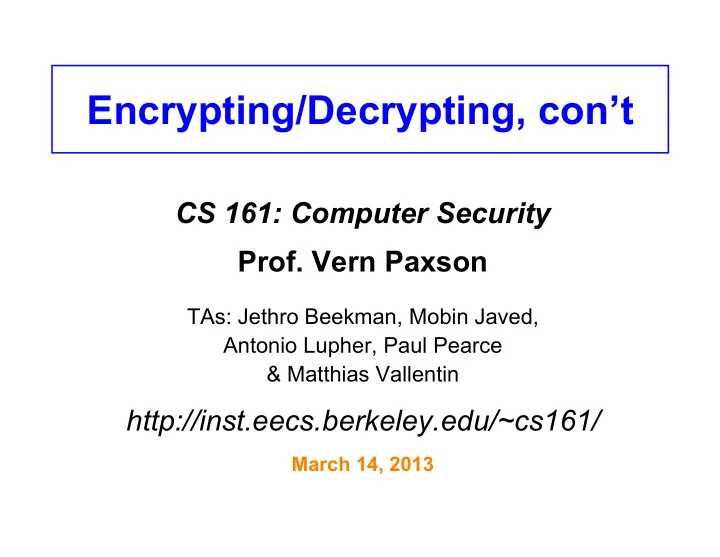

Encrypting/Decrypting, con’t CS 161: Computer Security Prof. Vern Paxson TAs: Jethro Beekman, Mobin Javed, Antonio Lupher, Paul Pearce & Matthias Vallentin http://inst.eecs.berkeley.edu/~cs161/ March 14, 2013
Announcements / Goals For Today • It’s prudent to double-check the summing used on your midterm scores • In general, see course homepage for procedure to request re-grading • For Project #1, be sure to read Neo’s tweets • Today: – Review main themes from last lecture – Stream ciphers: approximating one-time pads – Begin public-key cryptography: no shared keys!
Review of Where We’re At • Alice employs an Encryptor E to produce ciphertext from plaintext . • Bob employs a Decryptor D to recover plaintext from ciphertext. • So far, both E and D are configured using the same key K . • K is a shared secret between Alice and Bob – Eavesdropper Eve doesn’t know it (otherwise, disaster! ) • Use of same secret key for E and D ⇒ “symmetric key cryptography”
One-Time Pad • For each message, use a new, independent key • Key has same length as message; C = M ⊕ K • Provably secure … if we stick to these requirements • Reuse of key = disaster – Eve can learn about relationships between messages – For known plaintext attacks, Eve can recover K and thus new message encrypted with its reuse • Not practical in most circumstances due to requiring huge volume of shared secret keys
Block Ciphers • Given a key, creates a seemingly random bijective mapping on bitstrings of length n {0, 1} n → {0, 1} n n is the blocksize • A popular, solid block cipher: AES – Block size n = 128 bits – Keys can be 128/192/256 bits (all work fine) – As usual, AES defines both an encryptor and a decryptor function. They use the same key K. • AES is very strong: no known significant flaws – Change single bit in key or plaintext ⇒ output appears completely different • In general, we think of block ciphers as one form of “primitive” that we then build on
Block Cipher Modes • Problem with using block ciphers: what if message M not the same size as n (blocksize)? – If M smaller than n, we pad it • Don’t worry about how to choose the padding or figure out the exact length (these aren’t hard) – If M larger than n, need multiple instances of block cipher • A block cipher mode = procedure to use multiple instances of block cipher to encrypt a single msg • Modes are tricky! We want to make sure they don’t leak information: – Not give away parts of message that are related – Not give away relationships between different messages
Block Cipher Modes, con’t • Simplest mode (ECB) fails (recall penguin image) • To mask relationships between different blocks of M, ensure each block is “seeded” with something (very-)hard-to-predict – Lecture mentioned “intermingling”; that’s one way to do it • To mask relationships between different messages, seed each use of a block cipher mode w/ unique # – Initialization Vector (IV) – A type of nonce: a value used only once (single context) • Important: IV is not sensitive! – Alice sends (IV, C) to Bob. Eve can see IV . • This led us to CBC = Cipher Block Chaining mode
P 1 P 2 P 3 C 1 C 2 C 3 (Nonce = Same as IV)
C 1 C 2 C 3 P 1 P 2 P 3 (Note, uses block cipher’s encryption functionality, not decryption)
Recommend
More recommend